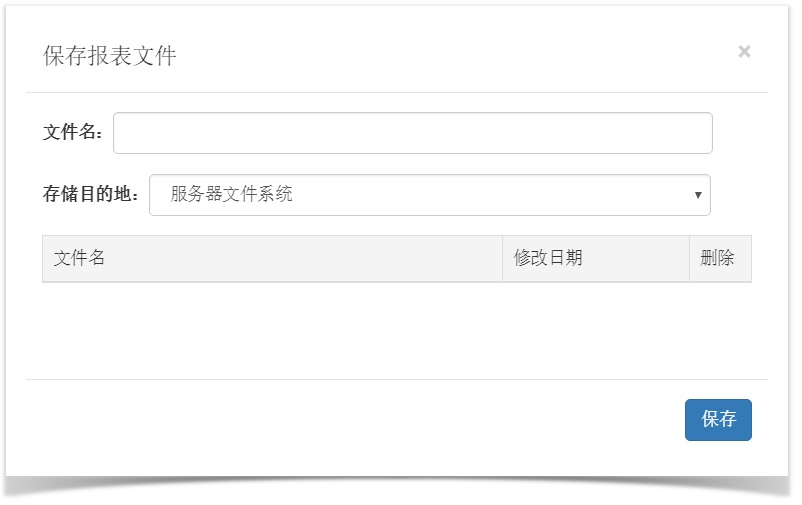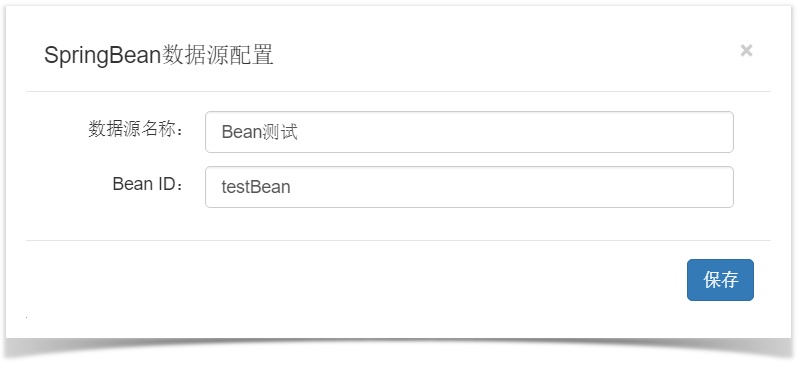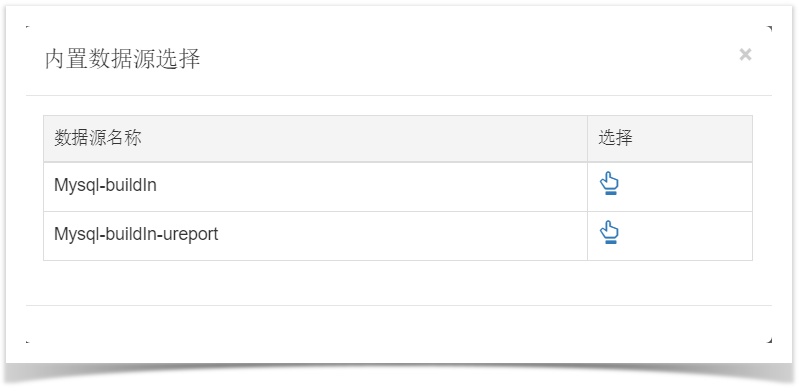
UReport2 报表存储与数据源配置
UReport2教学视频
http://pan.baidu.com/s/1boWTxF5,密码:98hj
UReport商业版BaskReport已推出,采出全新算法,全新设计器,实现百万条数据秒级加载, 价格低至1000/年,详见:https://www.basksoft.com
UReport商业版BaskReport已推出,采出全新算法,全新设计器,实现百万条数据秒级加载, 价格低至1000/年,详见:https://www.basksoft.com
报表存储目录配置
在第二小节中,我们介绍如何搭建一个包含UReport2的项目,在运行项目后,我们发现在项目的WEB-INF目录有会自动生成了一个名为“ureportfiles”目录,这个目录是UReport2提供的默认的报表文件存储目录,也就是说默认情况下,UReport将在项目的WEB-INF/ureportfiles目录下存储设计好的报表文件。
默认报表存储目录
如果您的项目在Eclipse的开发环境运行时,采用的是jetty(比如run-jetty-run插件),那么就可以在项目的WEB-INF目录下发现一个名为“ureportfiles”目录。
但如果你采用tomcat运行项目,那么在WEB-INF目录下就没有一个名为“ureportfiles”目录,原因是在Eclipse中运行tomcat,tomcat需要创建一个临时的工作目录(该目录一般位于workspace\.metadata\.plugins\org.eclipse.wst.server.core\tmp0\wtpwebapps\下),所以采用tomcat运行项目,则需要到这个临时的工作目录下找到对应的项目,再到这个项目的WEB-INF目录下找到对应的“ureportfiles”目录。
运行我们搭建好的项目,打开报表设计器,点击工具栏上的保存按钮( ),选择“保存”,可以看到如下图所示的弹出窗口:
),选择“保存”,可以看到如下图所示的弹出窗口:
 \
\
在这个窗口,我们只要输入报表名称,同时再选择报表的存储目的地就,可以保存当前报表文件。可以看到,UReport2默认给我们提供的存储目的地是“服务器文件系统 ”,实际上就是我们项目中WEB-INF目录下的“ureportfiles”目录,这个目录是系统默认自动生成的,如果需要我们可以添加一个属性来更改这个目录位置。
在我们项目的WEB-INF目录下创建一个名为config.properties,打开位于WEB-INF下名为context.xml的spring配置文件,在其中添加如下Bean以加载这个config.properties文件(如果我们的项目中已有自己的Properties文件,那么直接在这个Properties文件中配置即可)。
<bean id="propertyConfigurer" parent="ureport.props">
<property name="location">
<value>/WEB-INF/config.properties</value>
</property>
</bean>说明
上面的Bean配置,实际上就是一个标准的org.springframework.beans.factory.config.PropertyPlaceholderConfigurer类配置,我们知道通过配置PropertyPlaceholderConfigurer,可以实现加载Spring外部properties的作用,所以如果您的项目中已配置了PropertyPlaceholderConfigurer类,那么直接在这个类对应的properties文件中添加对应的UReport2属性即可,而不需要额外配置config.properties文件。
打开config.properties文件,在其中添加名为“ureport.fileStoreDir”的属性,该属性的值用于定义UReport2中提供的默认基于文件系统的报表存储目录,比如定义该属性为下面样式:
属性值定义示例
ureport.fileStoreDir=D:/ureportfiles
表示在D盘根下名为ureportfiles的目录中存储报表文件,需要注意的是,这里指定特定目录时,一定要保存这个目录已存在,否则将不会被采用,比如上面的D盘下名为ureportfiles的目录,就需要我们预先创建好。
自定义报表存储器
UReport2默认提供的名为“服务器文件系统”的报表存储机制,实际上是实现了UReport2提供的com.bstek.ureport.provider.report.ReportProvider接口,该接口源码如下:
package com.bstek.ureport.provider.report;
import java.io.InputStream;
import java.util.List;
/**
* @author Jacky.gao
* @since 2016年12月4日
*/
public interface ReportProvider {
/**
* 根据报表名加载报表文件
* @param file 报表名称
* @return 返回的InputStream
*/
InputStream loadReport(String file);
/**
* 根据报表名,删除指定的报表文件
* @param file 报表名称
*/
void deleteReport(String file);
/**
* 获取所有的报表文件
* @return 返回报表文件列表
*/
List<ReportFile> getReportFiles();
/**
* 保存报表文件
* @param file 报表名称
* @param content 报表的XML内容
*/
void saveReport(String file,String content);
/**
* @return 返回存储器名称
*/
String getName();
/**
* @return 返回是否禁用
*/
boolean disabled();
/**
* @return 返回报表文件名前缀
*/
String getPrefix();
} 实现了ReportProvider接口后,只需要将实现类配置到Spring中,让其成为一个标准的Spring Bean,这样UReport2就会检测到它而将其加载。下面是UReport2默认提供的名为“服务器文件系统”的报表存储器源码:
package com.bstek.ureport.provider.report.file;
import java.io.File;
import java.io.FileInputStream;
import java.io.FileNotFoundException;
import java.io.FileOutputStream;
import java.io.IOException;
import java.io.InputStream;
import java.util.ArrayList;
import java.util.Calendar;
import java.util.Collections;
import java.util.Comparator;
import java.util.List;
import javax.servlet.ServletContext;
import org.apache.commons.io.IOUtils;
import org.springframework.beans.BeansException;
import org.springframework.context.ApplicationContext;
import org.springframework.context.ApplicationContextAware;
import org.springframework.web.context.WebApplicationContext;
import com.bstek.ureport.exception.ReportException;
import com.bstek.ureport.provider.report.ReportFile;
import com.bstek.ureport.provider.report.ReportProvider;
/**
* @author Jacky.gao
* @since 2017年2月11日
*/
public class FileReportProvider implements ReportProvider,ApplicationContextAware{
private String prefix="file:";
private String fileStoreDir;
private boolean disabled;
@Override
public InputStream loadReport(String file) {
if(file.startsWith(prefix)){
file=file.substring(prefix.length(),file.length());
}
String fullPath=fileStoreDir+"/"+file;
try {
return new FileInputStream(fullPath);
} catch (FileNotFoundException e) {
throw new ReportException(e);
}
}
@Override
public void deleteReport(String file) {
if(file.startsWith(prefix)){
file=file.substring(prefix.length(),file.length());
}
String fullPath=fileStoreDir+"/"+file;
File f=new File(fullPath);
if(f.exists()){
f.delete();
}
}
@Override
public List<ReportFile> getReportFiles() {
File file=new File(fileStoreDir);
List<ReportFile> list=new ArrayList<ReportFile>();
for(File f:file.listFiles()){
Calendar calendar=Calendar.getInstance();
calendar.setTimeInMillis(f.lastModified());
list.add(new ReportFile(f.getName(),calendar.getTime()));
}
Collections.sort(list, new Comparator<ReportFile>(){
@Override
public int compare(ReportFile f1, ReportFile f2) {
return f2.getUpdateDate().compareTo(f1.getUpdateDate());
}
});
return list;
}
@Override
public String getName() {
return "服务器文件系统";
}
@Override
public void saveReport(String file,String content) {
if(file.startsWith(prefix)){
file=file.substring(prefix.length(),file.length());
}
String fullPath=fileStoreDir+"/"+file;
FileOutputStream outStream=null;
try{
outStream=new FileOutputStream(new File(fullPath));
IOUtils.write(content, outStream,"utf-8");
}catch(Exception ex){
throw new ReportException(ex);
}finally{
if(outStream!=null){
try {
outStream.close();
} catch (IOException e) {
e.printStackTrace();
}
}
}
}
@Override
public boolean disabled() {
return disabled;
}
public void setDisabled(boolean disabled) {
this.disabled = disabled;
}
public void setFileStoreDir(String fileStoreDir) {
this.fileStoreDir = fileStoreDir;
}
@Override
public void setApplicationContext(ApplicationContext applicationContext) throws BeansException {
File file=new File(fileStoreDir);
if(file.exists()){
return;
}
if(applicationContext instanceof WebApplicationContext){
WebApplicationContext context=(WebApplicationContext)applicationContext;
ServletContext servletContext=context.getServletContext();
String basePath=servletContext.getRealPath("/");
fileStoreDir=basePath+fileStoreDir;
file=new File(fileStoreDir);
if(!file.exists()){
file.mkdirs();
}
}
}
@Override
public String getPrefix() {
return prefix;
}
}禁用系统提供的默认报表存储器
如果我们定义了自己的报表存储器,同时又不想再使用系统默认提供的”服务器文件系统“的报表存储器,那么我们只需要在之前介绍的config.properties文件中添加一个名为ureport.disableFileProvider属性,将其值设置成true即可。
通过上面的介绍,可以看到,通过实现ReportProvider接口,我们可以很容易的开发出其它类型的报表存储器,比如开发一个新的报表存储器将报表文件存储到数据库、FTP等。
配置报表数据源
打开UReport2的报表设计器,可以看到UReport2提供了三种类型的报表数据源,如下图所示:

三种类型的数据源分别是直接连接数据库,Spring Bean以及通过实现com.bstek.ureport.definition.datasource.BuildinDatasource接口提供的内置数据源。
直接连接数据库比较简单,就是在项目的classpath中添加好相应数据库的驱动Jar包后,在弹出的窗口中配置数据源连接信息即可,如下图所示:

Spring Bean类型的数据源可以选择Spring上下文中定义好的一个Bean来作为数据源,点击 图标,在弹出的窗口中输入数据源名称及要采用的Bean的ID,如下图所示:
图标,在弹出的窗口中输入数据源名称及要采用的Bean的ID,如下图所示:

保存后,就可以在这个数据源下添加具体的数据集,添加方法就是在这个数据源下右键,在弹出的菜单中选择添加数据集,在弹出的窗口中定义数据集名称、对应的方法名以及返回对象类型,如下图所示:

在Spring bean数据集配置中,方法名我们可以点击右侧的“选择方法”按钮来选择当前Bean对应的类中定义的方法,但这里对方法的要求是:方法必须要有三个参数,依次是String,String,Map,比如我们上面定义的testBean里就包含两个合法的方法,如下所示:
package com.ureport.test;
import java.util.List;
import java.util.Map;
/**
* @author Jacky.gao
* @since 2017年2月7日
*/
public class TestBean {
public List<Map<String,Object>> loadReportData(String dsName,String datasetName,Map<String,Object> parameters){
return null;
}
public List<Map<String,Object>> buildReport(String dsName,String datasetName,Map<String,Object> parameters){
return null;
}
} 所以对于一个合法的Bean数据集方法要有三个参数,分别是String,String,Map,依次对应数据源名称、数据集名称以及外部传入的参数Map,Bean的方法只有是这种结构才可以选择。对于数据集方法的返回值,目前来说可以支持两种类型,一种是我们TestBean中返回的Map<String,Object>类型的List集合;另一种就是返回一个POJO类型的List集合,比如像下面的方法:
public List<User> loadData(String dsName,String datasetName,Map<String,Object> parameters){
return null;
} 在上面的示例方法中,返回的就是User对象集合,这里的User对象,就是一个普通的POJO对象。
内置数据源
这种类型的数据源,要示我们实现BuildinDatasource接口,同时将BuildinDatasource接口实现类配置到Spring即可,BuildinDatasource接口源码如下:
package com.bstek.ureport.definition.datasource;
import java.sql.Connection;
/**
* @author Jacky.gao
* @since 2017年2月9日
*/
public interface BuildinDatasource {
/**
* @return 返回数据源名称
*/
String name();
/**
* @return 返回当前采用数据源的一个连接
*/
Connection getConnection();
} BuildinDatasource接口实现类配置到Spring中后,UReport2会自动检测到,这样在报表设计器中,点击数据源页签中的 按钮,在弹出的窗口中就可以选择定义好的内置数据源,如下图所示:
按钮,在弹出的窗口中就可以选择定义好的内置数据源,如下图所示:

对于UReport2提供的三种类型的数据源,各有其特点及适用场景,对于使用者来说,要根据它们的特点灵活选择。